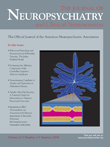Altered Sexual Orientation Following Dominant Hemisphere Infract
To the Editor: Human sexual behavior is a complex subject that has proved challenging to scientists of all disciplines. Psychological theories 1 as well as biological concepts 2 , 3 have been proposed to address sexual behavior and, in particular, human sexual orientation. The subject is further complicated by moral and ethical views widely prevalent in all societies. We report on a case of altered sexual orientation following an infarct in the left middle cerebral artery region.
Case Report
The patient, a 57-year-old right-handed man, sustained his first cerebral vascular accident in the right middle cerebral artery region at the age of 45, which resulted in right-sided hemiparesis that resolved completely within 3 months. He continued to run his private business successfully while living with his mother.
The patient lost his father in early childhood. There was no evidence of an emotional or conduct disorder during school years, and the patient eventually obtained his university degree. He continued to manage his successful practice until he sustained the second cerebral vascular accident in the left middle cerebral artery region at age 53.
The patient became aware of his homosexual orientation in his early teens and had several gay partners. He suffered a major depressive episode at age 26 that resolved within a few months. He also had a diagnosis of excessive harmful use of alcohol, but there was no evidence of dependence.
The patient started complaining of his changed personality and heterosexual orientation 6 months after his second stroke. At the same time he complained of excessive mood swings and changed interests. He became preoccupied with photography and had a successful photographic exhibition a year after his second stroke. His sexual orientation remained heterosexual 4 years following the second stroke, and he preferred to describe himself as bisexual because of his previous homosexual orientation.
Discussion
The mechanism by which a person acquires his sexual orientation is complex and ranges from pure psychological theories to more complex biological concepts. Our patient was aware of his homosexual orientation beginning in his early teens. He always enjoyed his gay relationships and had had at some point a live-in partner. He grew up with an absent father and had a strong bond with his mother. He went back to live with his mother after separating from his partner 4 years before his first stroke. It is unlikely that his psychological reaction to his first and/or second stroke could explain his altered sexual orientation, and his sexuality was accepted by his social network and family members.
Taking into consideration the interval between his first and second stroke, it is likely that an organic process within the left middle cerebral artery region is the cause of his altered sexual orientation.
The sexual needs of patients suffering from a brain injury are centered on hyper- and hyposexuality rather than altered sexual orientation. The alteration of sexual orientation raises serious challenges to patients and their care. It may be essential to address the issue of sexual orientation in assessing patient needs following brain injury in addition to other possible behavioral changes that might be encountered.
1. Arnold AP: The garden of voice within: the normal origin of sex difference in the brain. Curr Opin Neurol 2003; 13:759–766Google Scholar
2. Baily JM, Pillar RC: Genetics of human sexual orientation. Annu Rev Sex Res 1995; 6:126–156Google Scholar
3. Wegesin DJ: A neuropsychological profile of homosexual and heterosexual men and women. Arch Sex Behav 1998; 27:91–108Google Scholar



